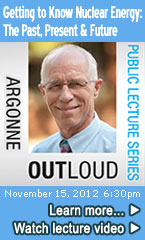Detection & Diagnostic Systems
|
|
The Detection & Diagnostic Systems Department conducts research and development related to instruments and non-destructive evaluation (NDE) techniques for characterization of materials and determination of system parameters related to different energy systems (including fossil, transportation, and nuclear). The Department also develops sensors and technologies for non-energy-producing applications such as homeland security and biomedical engineering.
Sensors & Instrumentation and NDE Applications
- Sensors, Instrumentation, and Nondestructive Evaluation: Overview
- Energy System Applications
- Safety-Related Applications
- Homeland Security Applications
- Biomedical Applications
- Ion-mobility Spectrometry Based NOx Sensor
- Publications
Tech Initiatives Applications
Capabilities
Programs
- Nuclear Regulatory Research
Facilities
- Laser Applications Laboratory (LAL)
- Non-destructive Evaluation (NDE) and Testing Facilities
- Robotics Laboratory (RL)
News Releases / In the Press
- NE Scientists Chien, Sheen, Raptis and
Wang win R&D 100 Award
NE Highlight (Aug. 26, 2011) - Sasan Bakhtiari (NDE Section) to take
part in annual U.S. Frontiers of Engineering symposium
NE Highlight (Sep. 8, 2008) - CNN
reports on Passive millimeter-wave spectroscopy (PmmWS)
CNN's "Situation Room" recently focused on Argonne technologies with anti-terrorism applications. Passive millimeter-wave spectroscopy is one of the technologies featured in the report.
The video clip is available on the CNN website. - New T-ray source
could improve airport security, cancer detection
Argonne News Release (Nov. 23, 2007) - BioTime
Announces Joint Hypothermic Medicine Study With Argonne National Laboratory
BioTime Press Releases (Nov. 2, 2007) - New system could
provide safer, cheaper, more detailed mammograms
Argonne News Release (Oct. 26, 2007) - Gopalsami interviewed on security technology
See Multimedia Gallery - New instrument
covertly detects signals from illicit chemicals
Argonne News Release (Aug. 31, 2007) - NE researchers win two R&D 100 Awards
NE Highlights (Aug.21, 2007) - New sensor technology
detects chemical, biological, nuclear and explosive materials
Argonne News Release (Mar. 21, 2006) - Inspection technologies
protect and enhance materials for power plants
Argonne News Release (Aug. 5, 2005) - NASA honors Argonne's
Ellingson
Argonne News Release (Feb. 8, 2005) - "Researchers
Honored in 2004: Saving lives instead of cooling buildings"
Argonne News Release (Aug. 23, 2004) - "Argonne,
NASA team up on shuttle safety"
Argonne News Release (Aug. 29, 2003) - "Ice smoothie gives
heart attacks the 'big Chill', may save lives"
Argonne logos, Spring 2003 - Tiny device can
detect hidden nuclear weapons, materials
Argonne News Release (Jun. 21, 2002)
Featured Documents
Fact Sheets:
IMPORTANT NOTE:
Documents listed in this page are in PDF format.
Download the latest and free version of Adobe's
Reader to view documents in PDF format. Problems with viewing/printing the PDF files:
PDF Help Notes (link opens in new browser
window).
- Argonne innovations in nondestructive evaluation technologies aid many industries - Fact Sheet -- [756KB];
- Millimeter-Wave Radar Detection of Chemicals, Gases, and Radiation - Fact Sheet -- [234KB]; also available at Argonne Technology Transfer Office
- Gallium Arsenide Semiconductor-based Neutron Detector - Fact Sheet
[174KB]; also available at Argonne Technology Transfer Office - Terahertz- and Millimeter-Wave Test Facility — Detect Terrorist-Related Contraband with Terahertz Technology - Fact Sheet -- [176KB]; also available at Argonne Technology Transfer Office
- Joining Advanced Materials By Plastic Flow Provides Solution For Oxygen Sensor Applications - Fact Sheet -- [191KB]; also available at Argonne Technology Transfer Office
Millimeter Wave Group’s Publications
Millimeter Wave Group’s Publications - The most recent publications by the MMW Group led by Argonne Expert Sami Gopalsami
Other featured publications
Emission of Coherent THz Radiation from Superconductors by
L. Ozyuzer, A. E. Koshelev, C. Kurter, N. Gopalsami, Q. Li, M. Tachiki,
K. Kadowaki, T. Yamamoto, H. Minami, H. Yamaguchi, T. Tachiki, K. E. Gray, W.-K. Kwok,
U. Welp
Compact solid-state sources of terahertz (THz) radiation are being sought for sensing,
imaging, and spectroscopy applications across the physical and biological sciences. We
demonstrate that coherent continuous-wave THz radiation of sizable power can be extracted
from intrinsic Josephson junctions in the layered high-temperature superconductor Bi2Sr2CaCu2O8.
In analogy to a laser cavity, the excitation of an electromagnetic cavity resonance inside
the sample generates a macroscopic coherent state in which a large number of junctions
are synchronized to oscillate in phase. The emission power is found to increase as the
square of the number of junctions reaching values of 0.5 microwatt at frequencies up to
0.85 THz, and persists up to ~50 kelvin. These results should stimulate the development
of superconducting compact sources of THz radiation... ~~ Excerpt from Science Magazine,
Vol. 318, 23 Nov. 2007
Download paper [![]() PDF (387KB)]; or
read the HTML version on Science
Magazine website
PDF (387KB)]; or
read the HTML version on Science
Magazine website
Multimedia
Visit the Detection & Diagnostic
Systems Multimedia
Gallery.
Items recently added to the gallery:
“Millimeter-Wave Remote Biometric
Identification and Tracking (RBIT) System for Security Applications” and “Compressive Passive
Millimeter-Wave Imager”
Awards
- 2011 R&D 100 Awards: Photoacoustic Spectroscopy (PAS) System for Remote Detection
of Explosives and Chemicals (Safety and Security)
NE Scientists Chien, Sheen, Raptis and Wang win R&D 100 Award - NE Highlight - 2007 R&D 100 Awards: Passive millimeter-wave spectroscopy (PmmWS)
- 2007 R&D 100 Awards: Ultra-High-Resolution Mammography System (UHRMS)
Recent Patents
- Surface acoustic wave probe implant for predicting epileptic seizures, N. Gopalsami, S. Kulikov, I. Osorio, A.C. Raptis, U.S. Patent 8,165,682 (Apr. 2012)
- High-temperature potentiometric oxygen sensor with internal reference, J.L. Routbort, D. Singh, P.K. Dutta, R. Ramasamy, J.V. Spirig, S. Akbar, U.S. Patent 8,057,652 (Nov. 2011)
Last Modified: Mon, February 4, 2013 6:50 PM









